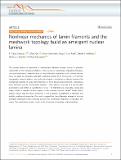Nonlinear mechanics of lamin filaments and the meshwork topology build an emergent nuclear lamina
Author(s)
Sapra, K Tanuj; Qin, Zhao; Dubrovsky-Gaupp, Anna; Aebi, Ueli; Müller, Daniel J; Buehler, Markus J; Medalia, Ohad; ... Show more Show less
DownloadPublished version (2.739Mb)
Publisher with Creative Commons License
Publisher with Creative Commons License
Creative Commons Attribution
Terms of use
Metadata
Show full item recordAbstract
The nuclear lamina—a meshwork of intermediate filaments termed lamins—is primarily responsible for the mechanical stability of the nucleus in multicellular organisms. However, structural-mechanical characterization of lamin filaments assembled in situ remains elusive. Here, we apply an integrative approach combining atomic force microscopy, cryo-electron tomography, network analysis, and molecular dynamics simulations to directly measure the mechanical response of single lamin filaments in three-dimensional meshwork. Endogenous lamin filaments portray non-Hookean behavior – they deform reversibly at a few hundred picoNewtons and stiffen at nanoNewton forces. The filaments are extensible, strong and tough similar to natural silk and superior to the synthetic polymer Kevlar®. Graph theory analysis shows that the lamin meshwork is not a random arrangement of filaments but exhibits small-world properties. Our results suggest that lamin filaments arrange to form an emergent meshwork whose topology dictates the mechanical properties of individual filaments. The quantitative insights imply a role of meshwork topology in laminopathies.
Date issued
2020-12Department
Massachusetts Institute of Technology. Laboratory for Atomistic and Molecular MechanicsJournal
Nature Communications
Publisher
Springer Science and Business Media LLC
Citation
Sapra, K.T. et al. Nonlinear mechanics of lamin filaments and the meshwork topology build an emergent nuclear lamina. Nat Commun 11, 6205 (2020) © 2020, The Author(s).
Version: Final published version
ISSN
2041-1723